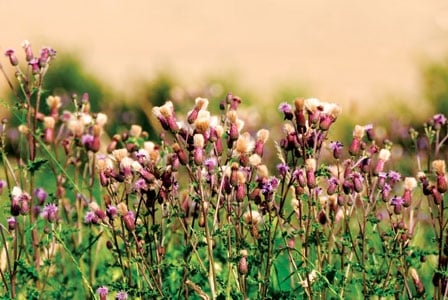
Milk thistle has been used medicinally since the fourth century BCE and has a wide variety of health benefits and health properties, especially for the liver.
Even though milk thistle (Silybum marianum) is not a new herb to the health food industry, the studies and clinical evidence of this amazing medicinal botanical continue to expand each year.
In addition to its well-documented effects of protecting and rejuvenating the liver, we now know that milk thistle also has antioxidant, anti-inflammatory, antifibrotic, antibacterial, and anticancer properties. It lowers cholesterol and arteriosclerosis, reduces metabolic syndrome (syndrome X) and insulin resistance, protects the kidneys, and reduces heavy metal toxicity.
Milk thistle has been used medicinally since the fourth century BCE. Both Greek and Roman doctors utilized it to protect the liver. English herbalist Nicholas Culpeper (1616 to 1654) used milk thistle to treat liver and spleen obstruction.
Milk thistle was so well known for its strong medicinal properties that early settlers brought it over to North America from its native land in Europe. It has since naturalized in North America, both growing in the wild as well as thriving under cultivation.
The modern uses of milk thistle focus on commercial preparations of milk thistle extract that contain 70 percent concentration of silymarin, the active constituent in this herb.
Liver protection
Research on the liver-protecting effects of milk thistle extract began in the 1970s and continues today. More than 150 clinical studies have shown that milk thistle extract protects and regenerates liver cells. It can reverse some hepatitis, repair liver cirrhosis, prevent gallstones, and rejuvenate kidney tissue.
Milk thistle extract’s immunomodulatory activity in liver disease is produced by its hepatoprotective (liver protecting) action and its increase in the activity of antioxidants (superoxide dismutase and glutathione peroxidase), which also explains its protective effects against free radicals.
In multiple studies of patients with acute viral hepatitis, silymarin shortened treatment time and showed improvement in serum levels of liver enzymes (bilirubin, alanine aminotranferease or ALT, and aspartate aminotransferase or AST). We have found that taking milk thistle along with shiitake, maitake, and coriolus mushrooms enhances milk thistle’s success in treating hepatitis and other liver complaints.
Cholesterol
It has been shown that patients taking milk thistle extract decrease the manufacture of liver cholesterol, as well as overall blood cholesterol, while increasing bile, cholate, and bilirubin excretion. Fourteen patients were given 420 mg milk thistle extract daily for three months, showing a decrease in total cholesterol as well as bad cholesterol. This effect is reflected in a reduction of atherosclerosis.
Diabetes
Silymarin shows promise in the treatment of both type 1 and type 2 diabetes because of its strong stimulating effects on the insulin receptor sites and by protecting tissues in insulin- dependent diabetics.
Anticancer
Silybin—the key component in silymarin—and silymarin itself have shown therapeutic efficacy in many forms of cancer, demonstrating cell growth inhibition in human breast and cervical carcinoma cells. Prostate cancer researchers theorize that silybin may synergize the therapeutic effects of the antibiotic doxorubicin in prostate cancer cells, making it a strong candidate for combination chemotherapy.
Other functions
Silymarin has a potent antibacterial activity, having inhibited gram-positive bacteria (those that are stained dark blue or violet) by reducing ribonucleic acid (RNA) and protein synthesis in these bacteria.
Silybin may also have antiallergic activity, as shown by its effect on histamine release in humans. Researchers theorize that silybin stabilizes membranes, possibly by interfering with calcium influx.
Silybin inhibition of human T-lymphocyte activation has also been reported, suggesting that the herb extract may potentially protect the liver in acute and chronic liver injury.
Dosage
The dosage of milk thistle is 200 to 600 mg of 70 percent extract, three times daily. Straight tinctures and the ground-up herb are not as effective as the concentrated extract. While milk thistle extract works well on its own, it has been our experience that milk thistle extract is most effective if combined with helping herbs. The botanicals we most often use with milk thistle are black radish, dandelion root, ginger root, parsley root, and burdock root.
Both human and animal studies show no chronic or acute toxicity to milk thistle, even in large doses. Milk thistle extract has been used for many health issues and is considered the medicine of choice for protecting the liver, kidney, and other capillary-rich tissues by most herbalists and naturopaths.

